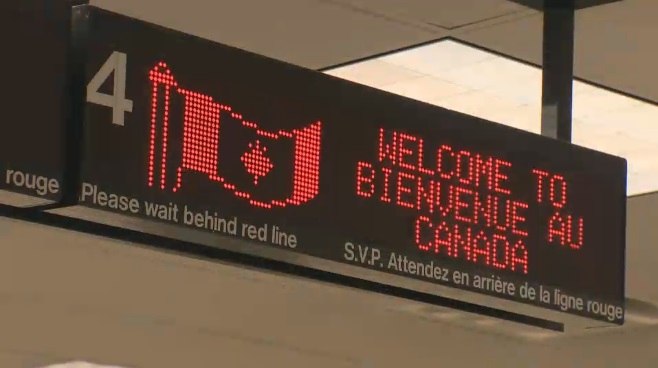Justin Trudeau‘s government has not yet told Canadians whether or how it intends to keep its long list of pre-COVID-19 promises.

One signature pledge was to take in 350,000 immigrants a year by 2021, or about one per cent of the population annually. That commitment was made in October 2018. At that time Canada was welcoming 310,000 newcomers a year.
Where does that major undertaking on immigration stand now, given that virtually nobody who is not already a citizen or resident of Canada has been allowed into the country for nearly two months? Or that Canadian embassies and immigration offices have almost all been closed or placed on greatly-reduced hours with much smaller staffs since sometime in February with little likelihood of much about that changing soon?
READ MORE: Ottawa will need post-mortem review of coronavirus response, Trudeau says
Official figures about immigration don’t tend to be released until one or two years after the fact, so it is guesswork trying to figure out how many newcomers Canada has welcomed this year or how many are in the pipeline. Surely, though, given that there are far fewer flights from overseas and that the required interviews and medical and security checks are clearly not taking place with most of the world shut down, there will be far fewer of these folks arriving this year. Because the immigration process is chronically slow and a maze for most potential immigrants, it is possible that there will be even fewer of them next year, too.

There is little public information available to help puzzle out the future of immigration to Canada during and after troubling times. But charts showing historical immigration numbers that were published by Statistics Canada five years ago may be instructive.
Whatever the boasts of the Harper and Trudeau governments about their openness to immigration, the fact is that immigration to Canada reached a peak of just over 400,000 people a year more than a century ago under then prime minister Sir Robert Borden. It then dropped to less than 40,000 a year for 15 years from the beginning of the Depression until the end of the Second World War under the Conservative and Liberal prime ministers, R.B. Bennett and Mackenzie King.
Considering this data and the grave current economic and logistical complications, if the current pattern mirrors the experience of the Depression, it is not too much of a stretch to suggest that what looms is a drastic drop — as much as 90 per cent — in immigration for several years.

There is no argument here about the merits of immigration, which I strongly support. It is about how many newcomers Ottawa now envisages Canada accepting and whether the public, faced with serious personal economic distress caused by unemployment and savings that have been wiped out, will be as supportive of immigration today or in, say, 2022 or 2023, as it was before the coronavirus pandemic disrupted lives and created so much uncertainty about the future.
It was the Mulroney government that decided to greatly increase the number of foreigners let into Canada. The policy was subsequently embraced by the Martin, Chrétien and Harper governments and expanded a bit further by the Trudeau government.
Recent immigrants, like generations of immigrants before them, have almost always been good for Canada. It is a generalization, but most of these settlers — if I may use a not so fashionable 19th and 20th-century term — have a reputation for working hard, often at jobs that those already lucky enough to be Canadians won’t do.
The newcomers help the economy by paying federal, provincial and municipal taxes. Their need for housing has pushed up the value of real estate, especially in the immigrant-magnet cities of Vancouver and Toronto (although a case can be made that this has sometimes been a mixed blessing).
READ MORE: No timeline for federal budget amid coronavirus uncertainty, Trudeau says
The presence of so many immigrants can only be good for a country where the spectre of depopulation has become real since many couples who can trace their Canadian roots back decades or centuries have become famously uninterested in having more than one or two kids.
Besides, the points system used to decide who qualifies to come to Canada has attracted many highly educated, highly motivated immigrants. The longstanding family sponsorship program has been a boon to, well, families. The legal refugees that Canada has taken in have helped people otherwise trapped in hellish situations. It has also given a little relief to poor countries such as Jordan and Lebanon that have unfairly had to bear far too much of the refugee burden.
But as during the Depression, Canada’s economic landscape has shifted dramatically in the past couple of months. The federal deficit for this year alone could be $252 billion. Similarly, big deficits are a prospect for 2021 and 2022. And the books of several provinces are worse than those of Ottawa.
The federal government has been very busy with the coronavirus. It is, after all, an epochal event.
But increased immigration was a strong theme as well as a firm promise of Trudeau’s government. The current pandemic should not prevent the immigration minister and senior department officials — who have lots of time on their hands since few new immigration applicants are being processed — from sharing their thoughts with Parliament and Canadians about how the COVID-19 shock has informed and affected their thinking and planning.
It is not too soon to start a national discussion about how many immigrants Canadians, their elected leaders and various business and ethnic communities think the economy and job market can digest.
Matthew Fisher is an international affairs columnist and foreign correspondent who has worked abroad for 35 years. You can follow him on Twitter at @mfisheroverseas







Comments